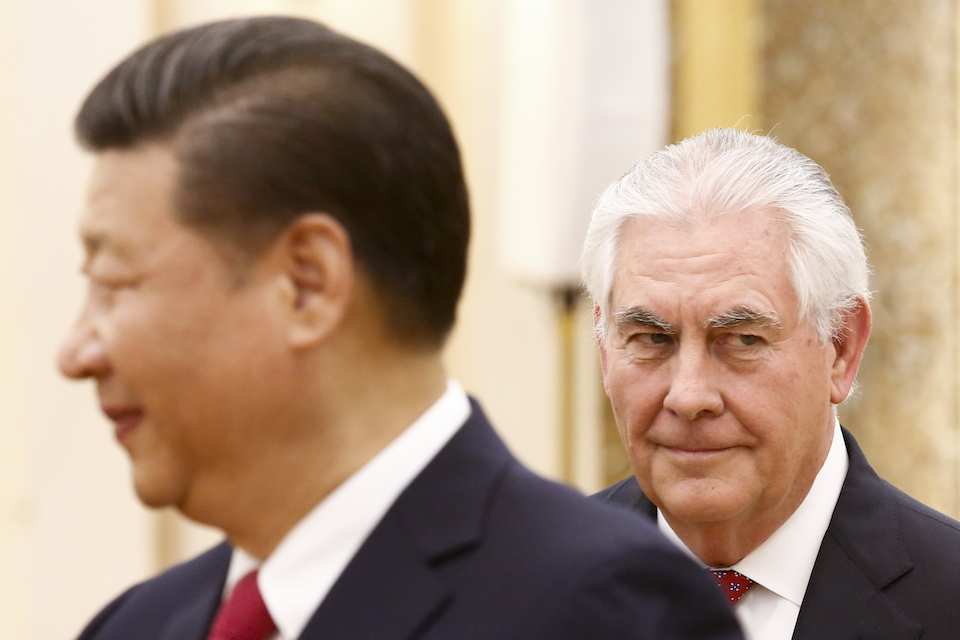What Just Happened in Beijing?
 China’s President Xi Jinping (L) meets US Secretary of State Rex Tillerson at the Great Hall of the People in Beijing on March 19, 2017.
Tillerson met Xi on March 19 just hours after a North Korean rocket engine test added new pressure on the big powers to address the threat from Pyongyang. / AFP PHOTO / POOL / THOMAS PETER (Photo credit should read THOMAS PETER/AFP/Getty Images)
China’s President Xi Jinping (L) meets US Secretary of State Rex Tillerson at the Great Hall of the People in Beijing on March 19, 2017.
Tillerson met Xi on March 19 just hours after a North Korean rocket engine test added new pressure on the big powers to address the threat from Pyongyang. / AFP PHOTO / POOL / THOMAS PETER (Photo credit should read THOMAS PETER/AFP/Getty Images)
Foreign Policy, 22 March 2017

By Robert Daly — No revelations were expected from Rex Tillerson’s first trip to China as U.S. Secretary of State; he invited only one journalist to accompany him, and seemed determined that his visit make no news. He nearly succeeded — but his repeated use of Chinese phrases earlier rejected by the Obama administration caused a stir in both Chinese and U.S. media. If the visit is remembered, it will be for the Trump administration’s adoption of Beijing’s diplomatic language and style. The tactic cannot have been well considered, and could prove misleading.
In public statements, Tillerson frequently cited Chinese President Xi Jinping’s favored prescription for “A New Model of Great Power Relations” — the awkward, controversial trinity of “no confrontation or conflict,” “mutual respect,” and “win-win solutions.” Tillerson then did Xi one better by claiming that the phrase not only could guide bilateral dealings going forward, but had in fact been the defining idea of U.S.-China relations over the past 40 years.
In fact, the New Model dates only to 2013, when Xi formally proposed the phrase at his Sunnylands summit with Barack Obama, and Obama parroted it back to him. After the summit, when China’s foreign minister elaborated on the “New Model” by saying it required avoidance of friction, mutual respect, and a joint search for win-win outcomes, Washington balked. “Mutual respect” was the major stumbling block, as it seemed to imply that both sides should recognize the other’s “core interests.” Americans worried that China’s core interests, which have historically included Tibet, Taiwan, and Xinjiang, were expanding to comprise much of the Western Pacific, where the U.S. too has core interests that conflict with China’s. RIP, New Model.
Chinese officials continued to use the slogan for years after America dropped it, probably because it was associated with Xi’s hallowed leadership. Even Xi seemed to have abandoned it by 2016, but now Tillerson has reawakened China’s hopes. Some American moderates see Tillerson’s reversal on “New Model” as an overdue recognition of the need to avoid war with a rising China. Others see a craven kow-tow.
It is more likely, however, that Xi’s slogan was simply used as placeholder language by a Trump administration that does not yet have a China policy.
It is more likely, however, that Xi’s slogan was simply used as placeholder language by a Trump administration that does not yet have a China policy. President Trump has not yet convened experts from the diplomatic, military, and intelligence communities to conduct a thorough review of U.S. strategies in East Asia and China. The White House has not had time to conduct the necessary meetings, has not appointed officials who would have to participate in them, and, in any event, does not appear prioritize such work.
At least two questions follow. First, can Xi rely on Tillerson’s seeming enthusiasm as evidence that Trump is committed to constructive engagement with China, or to building a partnership, as Beijing understands the word? That’s easy: No. Candidate Trump’s warnings about China’s predatory behavior have been too heartfelt, and the economic, strategic, and ideological sources of friction between the United States and China are too deep-seated for anyone to take Tillerson’s words at face value. His Beijing remarks can’t be judged until the Trump administration settles on a China policy over the course of the next year or two, or until a crisis forces the issue earlier.
The second question is how Xi’s favorite formulation made it into Tillerson’s talking points nearly verbatim in the first place. Neither Steve Bannon, nor Peter Navarro, nor any of Trump’s department secretaries — most of whom are either China hawks, China skeptics, or China newcomers — seem likely to have recommended its use.
This wholly Chinese phrase was probably one that the Chinese themselves suggested to the administration, either during a visit by one of Beijing’s emissaries or through the Chinese Embassy, which has its own channels of communication with the President’s staff. If this analysis is correct, a Chinese spokesman probably made the case that, after a rocky year in the relationship, Trump was more likely to succeed in negotiations if his administration first reassured Xi of his sincerity by publically mouthing the words Xi had been longing to hear. If that was the argument, Tillerson properly performed his role in the jointly choreographed dance that is leading up to the Trump-Xi summit in Mar-a-Lago in April. It would be unfair to call that a kow-tow.
Restricted media coverage, secret consensus, and public platitudes, all in the service of an upcoming summit that we can already declare a success — this was diplomacy in the Chinese style. But the Tillerson trip shouldn’t be over-analyzed. It wasn’t even Act I in the Trump-Xi era of U.S.-China relations. It was the tune up for the overture at most, and while there were false notes, it was not without promise.

